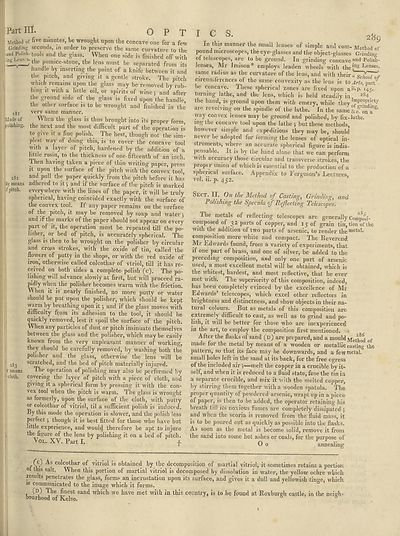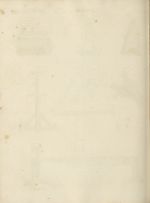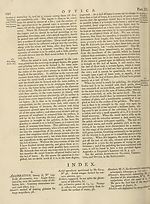Encyclopaedia Britannica > Volume 15, NIC-PAR
(339) Page 289
Download files
Complete book:
Individual page:
Thumbnail gallery: Grid view | List view

Part III.
OPT
281
Made of
polishing.
282
Method of five minutes, be wrought upon the concave one for a few
Grinding seconds, in order to preserve the same curvature to the
and Polish-tools and the glass. When one side is finished oif with
; the pumice-stone, the lens must be separated from its
handle by inserting the point of a knife between it and
the pitch, and giving it a gentle stroke. The pitch
which remains upon the glass may be removed by rub¬
bing it with a little oil, or spirits of wine; and after
the ground side of the glass is fixed upon the handle,
the other surface is to be wrought and finished in the’
very same manner.
When the glass is thus brought into its proper form,
the next and the most difficult part of the operation is
to give it a fine polish. The best, though not the sim¬
plest way of doing this, is to cover the concave tool
with a layer of pitch, hardened by the addition of a
little rosin, to the thickness of one-fifteenth of an inch.
Then having taken a piece of thin writing paper, press
it upon the surface of the pitch with the convex tool,
and pull the paper quickly from the pitch before it has’
py means adhered to it; and if the surface of the pitch is marked
fpitch. everywhere with the lines of the paper, it will be truly
spherical, having coincided exactly with the surface of
the convex tool. If any paper remains on the surface
of the pitch, it may be removed by soap and water;
and if the maiks of the paper should not appear on every
part of it, the operation must be repeated till the po¬
lisher, or bed of pitch, is accurately spherical. The
glass is then to be wrought on the polisher by circular
and cross strokes, with the oxide of tin, called the
flowers of putty in the shops, or with the red oxide of
iron" otherwise called colcothar of vtriol, till it has re¬
ceived on both sides a complete- polish (c). The po¬
lishing will advance slowly at first, but will proceed ra¬
pidly when the polisher becomes warm with the friction.
When it is nearly finished, no more putty or water
should he put upon the polisher, which should be kept
warm by breathing upon it; and if the glass moves with
difficulty from its adhesion to the tool, it should he
quickly removed, lest it spoil the surface of the pitch.
When any particles of dust or pitch insinuate themselves
between the glass and the polisher, which maybe easily
known from the very unpleasant manner of working,
they should be carefully removed, by washing both the
polisher and the glass, otherwise the lens will be
scratched, and the bed of pitch materially injured.
The operation of polishing may also be performed by
covering the layer of pitch with a piece of cloth, and
giving it a spherical form by pressing it with the con¬
vex tool when the pitch is warm. The glass is wrought
as formerly, upon the surface of the cloth, with putty
or colcothar of vitriol, til a sufficient polish is induced.
By this mode the operation is slower, and the polish less
perfect ; though it is best fitted for those who have but
little experience, and would therefore be apt to injure
the figure of the lens by polishing it on a bed of pitch.
Vol. XV. Part I. ^ p f
283
v means
cloth.
I c s. 28g
In this manner the small lenses of simple and com. Method of
pound microscopes, the eye-glasses and the object-glasses Grinding
of telescopes, are to be ground. In grinding concave811^ Polish-
lenses, Mr Imison * employs leaden wheels with the jng Tenses,
same radius as the curvature of the lens, and with their 1 ? ..
circumferences of the same convexity as the lens is toArts^pnrt'
be concave. These spherical zones are fixed upon amp. 145.
turning lathe, and the lens, which is held steadily in 2S4
the hand, is ground upon them with emery, while they I"1ProI«'!ety
are revolving on the spindle of the lathe. In the same&c^on a
way convex lenses may be ground and polished, by fix-lathe,
ing the concave tool upon the lathe ; but these methods,
however simple and expeditious they may be, should
never be adopted for forming the lenses of optical in¬
struments, where an accurate spherical figure is indis¬
pensable. It is by the band alone that we can perform
with accuracy those circular and transverse strokes, the
proper union of which is essential to the production of a
spherical surface. Appendix to Ferguson’s Lectures,
vol. ii. p. 452.
Sect. II. On the Method of Castings Grinding, and
Polishing the Specula of Reflecting Telescopes.
I lie metals of reflecting telescopes are generallycomposi-
composed of 32 parts of copper, and 15 of grain tin, tion of the
with the addition of two parts of arsenic, to render the metal*
composition more white and compact. The Reverend
Mr Edwards found, from a variety of experiments, that
if one part of brass, and one of silver, be added to the
preceding composition, and only one part of arsenic
used, a most excellent metal will be obtained, which is
the whitest, hardest, and most reflective, that he ever
met with. I he superiority of this composition, indeed,
has been completely evinced by the excellence of Mr
Edwards’ telescopes, which excel other reflectors in
brightness and distinctness, and show objects in their na~
tural colours. But as metals of this composition are
extremely difficult to cast, as well as to grind and po¬
lish, it will be better for those who are inexperienced
in the art, to employ the composition first mentioned.
Alter the flasks of sand (d) are prepared, and a mould Method of
made for the metal by means of a wooden or metallic casting the
pattern, so that its face may be downwards, and a fewmetalf
small boles left in the sand at its back, for the free egress
of the included air;—melt the copper in a crucible by it¬
self, and when it is reduced to a fluid state, fuse the tin in
a separate crucible, and mix it with the melted copper,
by stirring them together with a wooden spatula. The
proper quantity of powdered arsenic, wrapt up in a piece
of paper, is then to be added, the operator retaining his
breath till its noxious fumes are completely dissipated ;
and when the scoria is removed from the fluid mass, it
is to be poured out as quickly as possible into the flasks.
As soon as the metal is become solid, remove it from
the sand into some hot ashes or coals, for the purpose of
O o annealing
f th* colcothar of vitriol is obtained by the decomposition of martial vitriol, it sometimes retains a portion
ol this salt. When this portion of martial vitriol is decomposed by dissolution in water, the yellow ochre which
results penetrates the glass, forms an incrustation upon its surface, and gives it a dull and yellowish tinge, which
is communicated to the image which it forms.
(D) The finest sand which we have met with in this country, is to be found at Roxburgh castle, in the neidi*
oourhood of Kelso.
OPT
281
Made of
polishing.
282
Method of five minutes, be wrought upon the concave one for a few
Grinding seconds, in order to preserve the same curvature to the
and Polish-tools and the glass. When one side is finished oif with
; the pumice-stone, the lens must be separated from its
handle by inserting the point of a knife between it and
the pitch, and giving it a gentle stroke. The pitch
which remains upon the glass may be removed by rub¬
bing it with a little oil, or spirits of wine; and after
the ground side of the glass is fixed upon the handle,
the other surface is to be wrought and finished in the’
very same manner.
When the glass is thus brought into its proper form,
the next and the most difficult part of the operation is
to give it a fine polish. The best, though not the sim¬
plest way of doing this, is to cover the concave tool
with a layer of pitch, hardened by the addition of a
little rosin, to the thickness of one-fifteenth of an inch.
Then having taken a piece of thin writing paper, press
it upon the surface of the pitch with the convex tool,
and pull the paper quickly from the pitch before it has’
py means adhered to it; and if the surface of the pitch is marked
fpitch. everywhere with the lines of the paper, it will be truly
spherical, having coincided exactly with the surface of
the convex tool. If any paper remains on the surface
of the pitch, it may be removed by soap and water;
and if the maiks of the paper should not appear on every
part of it, the operation must be repeated till the po¬
lisher, or bed of pitch, is accurately spherical. The
glass is then to be wrought on the polisher by circular
and cross strokes, with the oxide of tin, called the
flowers of putty in the shops, or with the red oxide of
iron" otherwise called colcothar of vtriol, till it has re¬
ceived on both sides a complete- polish (c). The po¬
lishing will advance slowly at first, but will proceed ra¬
pidly when the polisher becomes warm with the friction.
When it is nearly finished, no more putty or water
should he put upon the polisher, which should be kept
warm by breathing upon it; and if the glass moves with
difficulty from its adhesion to the tool, it should he
quickly removed, lest it spoil the surface of the pitch.
When any particles of dust or pitch insinuate themselves
between the glass and the polisher, which maybe easily
known from the very unpleasant manner of working,
they should be carefully removed, by washing both the
polisher and the glass, otherwise the lens will be
scratched, and the bed of pitch materially injured.
The operation of polishing may also be performed by
covering the layer of pitch with a piece of cloth, and
giving it a spherical form by pressing it with the con¬
vex tool when the pitch is warm. The glass is wrought
as formerly, upon the surface of the cloth, with putty
or colcothar of vitriol, til a sufficient polish is induced.
By this mode the operation is slower, and the polish less
perfect ; though it is best fitted for those who have but
little experience, and would therefore be apt to injure
the figure of the lens by polishing it on a bed of pitch.
Vol. XV. Part I. ^ p f
283
v means
cloth.
I c s. 28g
In this manner the small lenses of simple and com. Method of
pound microscopes, the eye-glasses and the object-glasses Grinding
of telescopes, are to be ground. In grinding concave811^ Polish-
lenses, Mr Imison * employs leaden wheels with the jng Tenses,
same radius as the curvature of the lens, and with their 1 ? ..
circumferences of the same convexity as the lens is toArts^pnrt'
be concave. These spherical zones are fixed upon amp. 145.
turning lathe, and the lens, which is held steadily in 2S4
the hand, is ground upon them with emery, while they I"1ProI«'!ety
are revolving on the spindle of the lathe. In the same&c^on a
way convex lenses may be ground and polished, by fix-lathe,
ing the concave tool upon the lathe ; but these methods,
however simple and expeditious they may be, should
never be adopted for forming the lenses of optical in¬
struments, where an accurate spherical figure is indis¬
pensable. It is by the band alone that we can perform
with accuracy those circular and transverse strokes, the
proper union of which is essential to the production of a
spherical surface. Appendix to Ferguson’s Lectures,
vol. ii. p. 452.
Sect. II. On the Method of Castings Grinding, and
Polishing the Specula of Reflecting Telescopes.
I lie metals of reflecting telescopes are generallycomposi-
composed of 32 parts of copper, and 15 of grain tin, tion of the
with the addition of two parts of arsenic, to render the metal*
composition more white and compact. The Reverend
Mr Edwards found, from a variety of experiments, that
if one part of brass, and one of silver, be added to the
preceding composition, and only one part of arsenic
used, a most excellent metal will be obtained, which is
the whitest, hardest, and most reflective, that he ever
met with. I he superiority of this composition, indeed,
has been completely evinced by the excellence of Mr
Edwards’ telescopes, which excel other reflectors in
brightness and distinctness, and show objects in their na~
tural colours. But as metals of this composition are
extremely difficult to cast, as well as to grind and po¬
lish, it will be better for those who are inexperienced
in the art, to employ the composition first mentioned.
Alter the flasks of sand (d) are prepared, and a mould Method of
made for the metal by means of a wooden or metallic casting the
pattern, so that its face may be downwards, and a fewmetalf
small boles left in the sand at its back, for the free egress
of the included air;—melt the copper in a crucible by it¬
self, and when it is reduced to a fluid state, fuse the tin in
a separate crucible, and mix it with the melted copper,
by stirring them together with a wooden spatula. The
proper quantity of powdered arsenic, wrapt up in a piece
of paper, is then to be added, the operator retaining his
breath till its noxious fumes are completely dissipated ;
and when the scoria is removed from the fluid mass, it
is to be poured out as quickly as possible into the flasks.
As soon as the metal is become solid, remove it from
the sand into some hot ashes or coals, for the purpose of
O o annealing
f th* colcothar of vitriol is obtained by the decomposition of martial vitriol, it sometimes retains a portion
ol this salt. When this portion of martial vitriol is decomposed by dissolution in water, the yellow ochre which
results penetrates the glass, forms an incrustation upon its surface, and gives it a dull and yellowish tinge, which
is communicated to the image which it forms.
(D) The finest sand which we have met with in this country, is to be found at Roxburgh castle, in the neidi*
oourhood of Kelso.
Set display mode to:
![]() Universal Viewer |
Universal Viewer | ![]() Mirador |
Large image | Transcription
Mirador |
Large image | Transcription
Images and transcriptions on this page, including medium image downloads, may be used under the Creative Commons Attribution 4.0 International Licence unless otherwise stated. ![]()
| Encyclopaedia Britannica > Encyclopaedia Britannica > Volume 15, NIC-PAR > (339) Page 289 |
|---|
| Permanent URL | https://digital.nls.uk/192586105 |
|---|
| Attribution and copyright: |
|
|---|
| Shelfmark | EB.11 |
|---|---|
| Description | Ten editions of 'Encyclopaedia Britannica', issued from 1768-1903, in 231 volumes. Originally issued in 100 weekly parts (3 volumes) between 1768 and 1771 by publishers: Colin Macfarquhar and Andrew Bell (Edinburgh); editor: William Smellie: engraver: Andrew Bell. Expanded editions in the 19th century featured more volumes and contributions from leading experts in their fields. Managed and published in Edinburgh up to the 9th edition (25 volumes, from 1875-1889); the 10th edition (1902-1903) re-issued the 9th edition, with 11 supplementary volumes. |
|---|---|
| Additional NLS resources: |
|

